Selling Apps via Apple's Volume Purchase Program
/Alice and I have been discussing how we can expand our marketing outside of the mommy blogger space for Stories by Gus on the Go. For one, we are finding it more difficult this time around than a few years ago. Maybe we are less patient. More importantly, though, we want to diversify. Much like how in business it is risky to rely heavily on one customer or one revenue stream, it is simply too risky to rely on a single marketing idea.
One avenue we have tried with Gus 1 is targeting schools. However, due to the business model change for Stories[1], we will likely need to adapt our approach and maybe even our app a little.
But first, let me back up.
Back when I submitted our first app, Apple asked if I wanted to make Gus on the Go: Spanish available with a volume discount to educational institutions. I checked the box. This program allows schools to purchase 20 or more copies at half the price. If they purchase less than 20, they pay full price. It sounded good on the surface. I honestly did not give it a lot of thought.
As part of our marketing for Gus 1, Alice and I have tried several times to target schools and educational institutions with varying degrees of success. It is generally a hard market to break into because we are competing with other school necessities and limited budgets.
As it was explained to me by two former teachers[2], major purchases in each department usually occur at the end of the school year with the remaining budget. If a teacher wants something during the school year, the teacher would have to make a pretty convincing argument to get approval from the department head[3].
Despite the difficulties, we have had a measured amount of success.
Techniques
In no particular order, here are some of the things we have tried:
Cold emailing bilingual day cares: I individually emailed about 180 bilingual and multilingual day cares in Germany and offered promo codes to try out the app. This involved a ton of research and personalizing the emails to each day care based on the languages they offered and the people involved. This resulted in 8 responses.
Soliciting feedback from language teachers: We talked to several language teachers about what they would want in an app for their classes and got great tips. This helped us not only improve the quality of our app, but also develop some good relationships with teachers.
Speaking with a principal: I have also spoken with a principal, who I personally know. Not only did she put me in touch with one of her Spanish teachers, she also told other principals about the app.
Review sites aimed at teachers: We paid a site that specifically targets teachers in the UK to review our app and add it into their system.
Nothing: I think a lot of schools found out about us through our other marketing channels. This is not really targeting schools, but it is easy, since we are already doing it. The lesson? Always be marketing.
Results or: who does not love colorful graphs?
The following three graphs show how volume sales to schools increased compared to our overall sales. These graphs show only iOS, as Amazon and Google do not seem to have an educational discount program. Since revenue increased from year one to year two to year three, this necessarily means that the total revenue brought in by volume sales also increased.
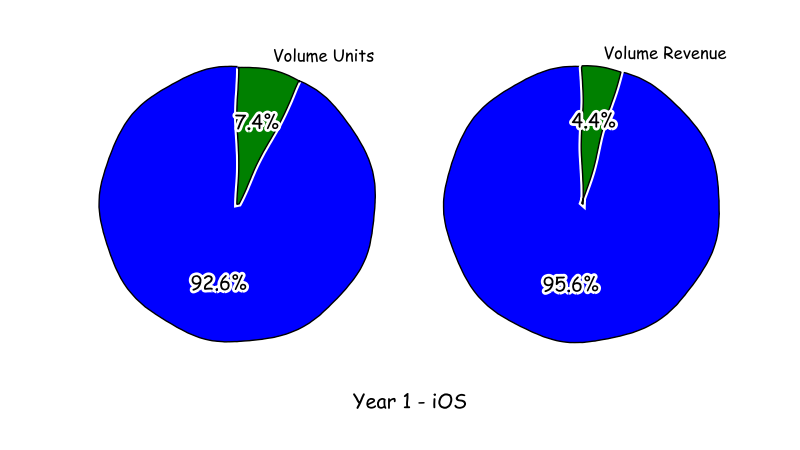
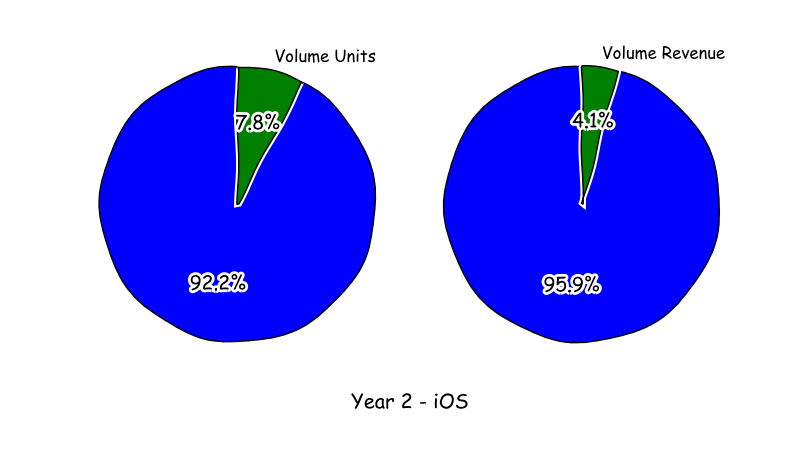
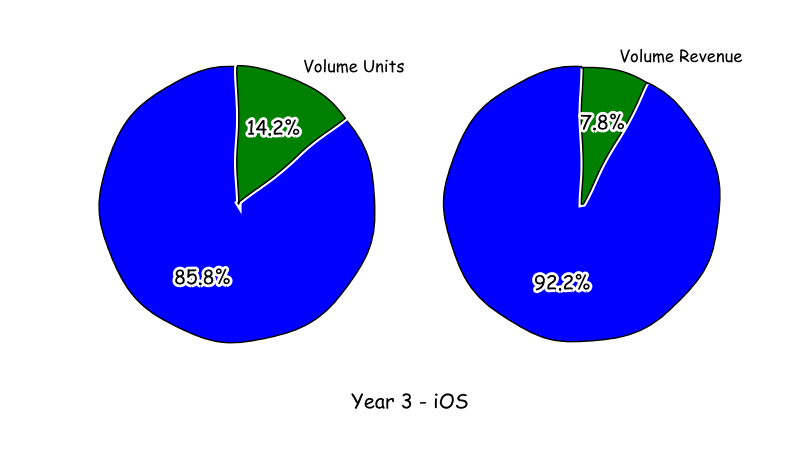
Additionally, the breakdown of volume sales by language roughly (but not exactly) follows our overall sales by language. Interesting, but not wholly unexpected.
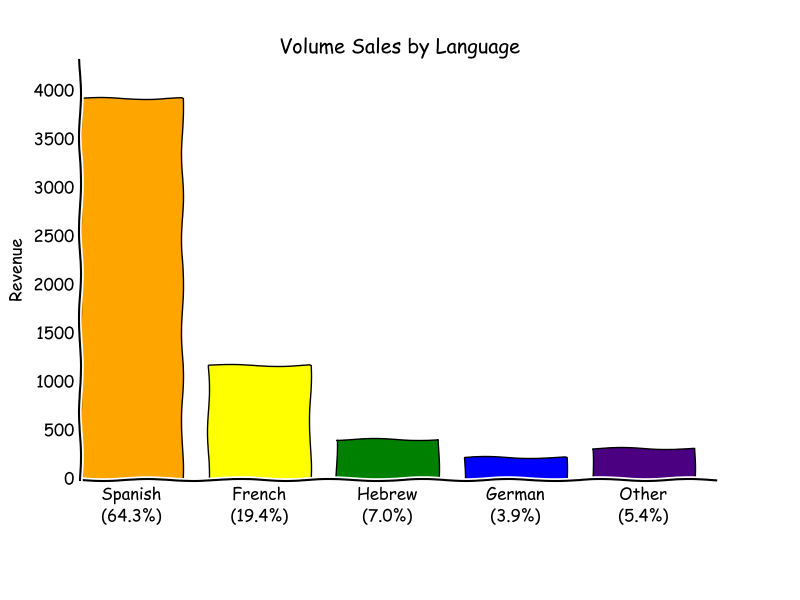
Finally, and my personal favorite, a histogram of volume sales by month. Here we see most of the schools, to which we sell, purchase at the beginning of the school year and throughout the first semester (August - December).
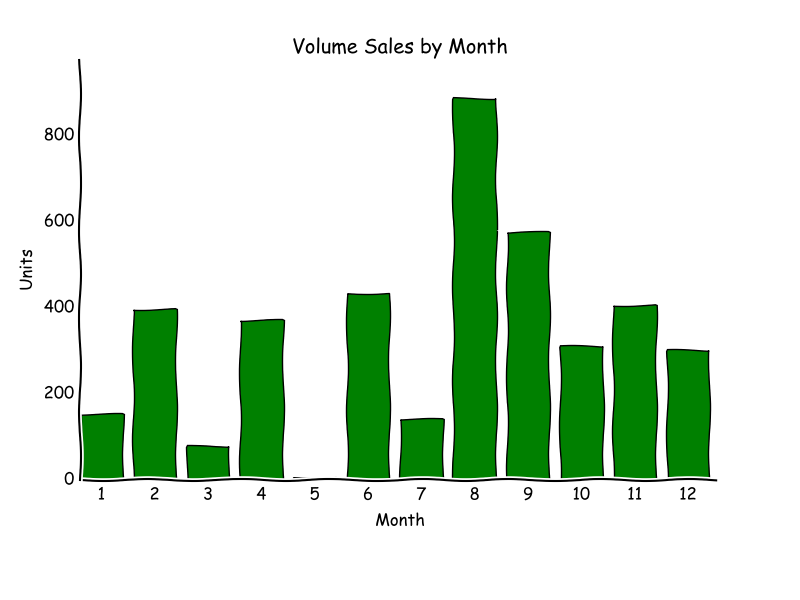
While this seems to run contrary to the explanation I received, I think it is indicative of something else. Although major purchases (read calculators, triple beam balances, Bunsen burners) are usually done at the end of the year, purchases of consumables (think erasers, markers, batteries) are done as needed throughout the year. My best guess is that our apps are cheap enough to not fall into the major purchases category. Especially when they are half off.
We are not a cup of coffee. We are an eraser.
Adapting Stories
There is a slight issue with our business model for Stories. The app is free but with in-app purchases. There is no volume purchase program for IAPs.
When purchasing through the volume purchase program, schools have two options to distribute content to students. Either they manage the distribution to particular users or devices via an app, or they use redeemable codes. Managed distributions allow schools to reassign users and devices at the end of the year but the redeemable codes are permanently tied to the accounts that redeem them.
The problem with our content driven business model:
- In-app purchases would have to be done manually on each device
- The student would have to pay for the IAPs, if the devices are not owned by the school
- No possibility to transfer the IAP to a new student the next year
- No volume discount
The best solution for Stories might be to create premium versions of the app in addition to our freemium versions. The idea would be to package up a new app every time we create about 4 story packs. These apps (Stories 1, Stories 2, etc…) would then be sold alongside the freemium version.
Shall we do a pro/con list? I thought you would never ask!
| Pros | Cons |
|---|---|
| More easily sell to schools | Lots of apps to maintain (languages * (1 + story packs / 4)) |
| Custom analytics to see how schools are using the apps | Customer confusion |
| Separate marketing copy targeted toward schools | Extra marketing |
You will notice marketing on both sides. On the cons side, it means that we will have to spend more time and energy on marketing, which is not necessarily a bad thing. It is simply not an easy thing. Especially not for me. I would rather be coding.
Where Do We Go From Here? (And Should We Really Care?)
If you have any thoughts or experiences on selling apps to educational institutions, I would love to hear from you. Or if you have first hand experience buying apps for a school, please get in touch. I have a ton of questions for you.
Start a conversation with me on Twitter. I’m @yonomitt. I’ll post there when I write more.
Have a nice day,
Yono
